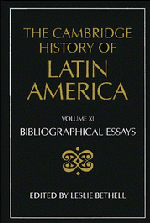Book contents
- Frontmatter
- I THE INDIGENOUS PEOPLES OF MIDDLE AND SOUTH AMERICA ON THE EVE OF THE CONQUEST
- II COLONIAL SPANISH AMERICA
- 1 The Spanish conquest and settlement of America
- 2 Indian societies and the Spanish conquest
- 3 Spain and America in the sixteenth and seventeenth centuries
- 4 Spain and America: The Atlantic trade, 1492–c.1720
- 5 Spain and America in the eighteenth century
- 6 Population
- 7 Urban development
- 8 Mining
- 9 The formation and economic structure of the hacienda in New Spain
- 10 The rural economy and society of Spanish South America
- 11 Aspects of the internal economy: Labour, taxation, distribution and exchange
- 12 Social organization and social change
- 13 Indian societies under Spanish rule
- 14 Africans in Spanish American colonial society
- 15 Women in Spanish American colonial society
- 16 The Catholic church
- 17 Literature and intellectual life
- 18 Architecture and art
- 19 Music
- III COLONIAL BRAZIL
- IV THE INDEPENDENCE OF LATIN AMERICA
- V LATIN AMERICA: ECONOMY, SOCIETY, POLITICS, c. 1820 TO c. 1870
- VI LATIN AMERICA: ECONOMY, SOCIETY, POLITICS, c. 1870 to 1930
- VII LATIN AMERICA: ECONOMY, SOCIETY, POLITICS, 1930 to c. 1990
- VIII IDEAS IN LATIN AMERICA SINCE INDEPENDENCE
- IX LATIN AMERICAN CULTURE SINCE INDEPENDENCE
- X THE INTERNATIONAL RELATIONS OF LATIN AMERICA SINCE INDEPENDENCE
- THE CAMBRIDGE HISTORY OF LATIN AMERICA
19 - Music
from II - COLONIAL SPANISH AMERICA
Published online by Cambridge University Press: 28 March 2008
- Frontmatter
- I THE INDIGENOUS PEOPLES OF MIDDLE AND SOUTH AMERICA ON THE EVE OF THE CONQUEST
- II COLONIAL SPANISH AMERICA
- 1 The Spanish conquest and settlement of America
- 2 Indian societies and the Spanish conquest
- 3 Spain and America in the sixteenth and seventeenth centuries
- 4 Spain and America: The Atlantic trade, 1492–c.1720
- 5 Spain and America in the eighteenth century
- 6 Population
- 7 Urban development
- 8 Mining
- 9 The formation and economic structure of the hacienda in New Spain
- 10 The rural economy and society of Spanish South America
- 11 Aspects of the internal economy: Labour, taxation, distribution and exchange
- 12 Social organization and social change
- 13 Indian societies under Spanish rule
- 14 Africans in Spanish American colonial society
- 15 Women in Spanish American colonial society
- 16 The Catholic church
- 17 Literature and intellectual life
- 18 Architecture and art
- 19 Music
- III COLONIAL BRAZIL
- IV THE INDEPENDENCE OF LATIN AMERICA
- V LATIN AMERICA: ECONOMY, SOCIETY, POLITICS, c. 1820 TO c. 1870
- VI LATIN AMERICA: ECONOMY, SOCIETY, POLITICS, c. 1870 to 1930
- VII LATIN AMERICA: ECONOMY, SOCIETY, POLITICS, 1930 to c. 1990
- VIII IDEAS IN LATIN AMERICA SINCE INDEPENDENCE
- IX LATIN AMERICAN CULTURE SINCE INDEPENDENCE
- X THE INTERNATIONAL RELATIONS OF LATIN AMERICA SINCE INDEPENDENCE
- THE CAMBRIDGE HISTORY OF LATIN AMERICA
Summary
The first histories of music written by Spanish Americans which include sections on the colonial period are José Sáenz Poggio, Historia de la música guatemalteca (Guatemala, 1878), republished in Anales de la Sociedad de Geografía e Historia de Guatemala, 22/1–2 (1947), 6–54, and Ramón de la Plaza, Ensayos sobre el arte en Venezuela (Caracas, 1883; facsimile reprint, 1977). Serafín Ramírez, La Habana artística (Havana, 1891) and Laureano Fuentes Matons, Las artes en Santiago de Cuba (Santiago, Cuba, 1893), although riddled with errors, contain some still useful information on the early nineteenth century. The historian Gabriel Saldívar y Silva published aged 25 his authoritative Historia de la musica en México (épocas precortesiana y colonial) (Mexico, D.F., 1934); it still remains uniquely valuable. In contrast with earlier Latin American music researchers, Saldívar was a palaeographer who exploited numerous documents in the ecclesiastical and secular archives of Mexico City. To him and his collaborator, his wife Elisa Osorio de Saldívar, belongs the honour of having preceded all other Latin Americans in treating their continent’s musical past dispassionately, and of having placed its study on a sound footing. The next scholar to write a history of his nation’s music was Eugenio Pereira Salas. His Los orígenes del arte musical en Chile (Santiago, Chile, 1941) still remains a model of method even though superseded in some factual aspects by Samuel Claro Valdés, Oyendo a Chile (Santiago, Chile, 1979). Alejo Carpentier, La música en Cuba (Mexico, D.F., 1946) is still quoted, partly because of the author’s fame in other fields.
- Type
- Chapter
- Information
- The Cambridge History of Latin America , pp. 160 - 162Publisher: Cambridge University PressPrint publication year: 1995

